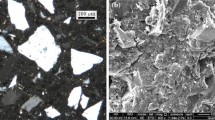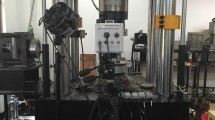Abstract
A multi-scale virtual internal bond (VIB) model for the isotropic materials has been recently proposed to describe the material deformation and fracturing. During the simulation process of material fracturing using VIB, the fracture criterion is directly built into the constitutive formulation of the material using the cohesive force law. Enlightened by the similarity of the damage constitutive model of rock under uniaxial compression and the cohesive force law of VIB, a VIB density function of rock under uniaxial compression is suggested. The elastic modulus tensor is formulated on the basis of the density function. Thus the complete deformation process of rock under the uniaxial compression is simulated.
Similar content being viewed by others
References
Gao H J, Klein P. Numerical simulation of crack growth in an isotropic solid with randomized internal cohesive bond [J]. Journal of the Mechanics and Physics of Solids, 1998, 46(2): 187–218.
Klein P, Gao H. Crack nucleation and growth as strain localization in a virtral-bond continuum [J]. Engineering Fracture Mechanics, 1998, 61: 21–48.
Ganesh T, Misra A. Fracture simulation for anisotropic materials using a virtual internal bond model [J]. International Journal of Solids and Structures, 2004, 41: 2919–2938.
Ganesh T, Hsia K J, Huang Y G. Finite element implementation of virtual internal bond model for simulating crack behavior [J]. Engineering Fracture Mechanics, 2004, 71(3): 401–423.
Lin P, Shu C W. Numerical solution of a virtual internal bond model for material fracture [J]. Physica D: Nonlinear Phenomena, 2002, 167(1–2): 101–121.
Gao H J, Ji B. Modeling fracture in nanomaterials via a virtual internal bond method [J]. Engineering Fracture Mechanics, 2003, 70(14): 1777–1791.
Ji B H, Gao H J. A study of fracture mechanisms in biological nano-composites via the virtual internal bond model [J]. Materials Science and Engineering A, 2004, 366(1): 96–103.
Ganesh T. Dynamic fracture simulation of concrete using a virtual internal bond model [J]. Journal of Engineering Mechanics, 2007, 133(5): 514–522.
Marsden J E, Hughes T J. Mathematical foundations of elasticity [M]. New Jersey: Prentice-Hall, Englewood Cliffs, 1983.
Ogden R W. Non-linear elastic deformations [M]. New York: John Wiley and Sons, 1984.
Wu Ji-ke, Wang Min-zhong, Wang Wei. Introduction to elastic mechanics [M]. Beijing: Beijing University Press, 2001 (in Chinese).
Tang C A. A new approach to numerical method of modeling geological process and rock engineering problem-continuum to discontinuum and linearity to nonlinearity [J]. Engineering Geology, 1998, 49(4): 207–214.
Jiang Yu. Fatigue failure and deformation development law of rock under cyclic load [D]. Shanghai: Shanghai Jiaotong University, 2003 (in Chinese).
Author information
Authors and Affiliations
Corresponding author
Rights and permissions
About this article
Cite this article
Ke, Cr., Jiang, Jl. & Ge, Xr. Numerical simulation of rock fracturing under uniaxial compression using virtual internal bond model. J. Shanghai Jiaotong Univ. (Sci.) 14, 423–428 (2009). https://doi.org/10.1007/s12204-009-0423-6
Received:
Published:
Issue Date:
DOI: https://doi.org/10.1007/s12204-009-0423-6




